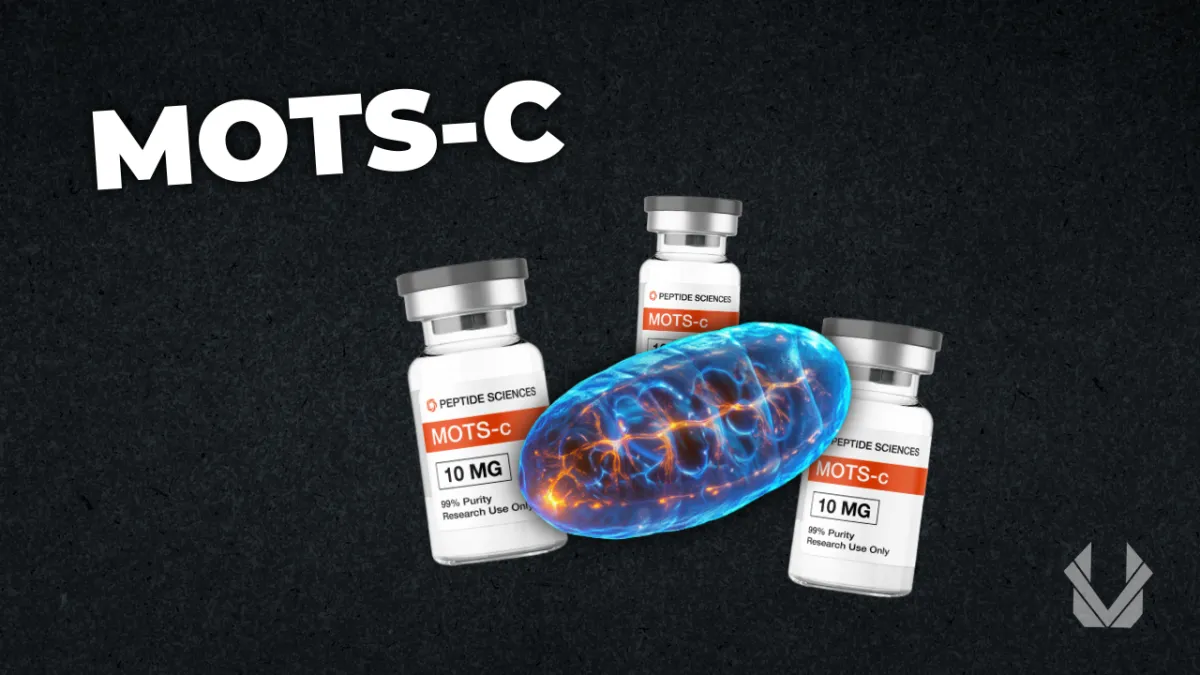THE UNYIELDING VIGOR BLOG
Our goal is to give you the most scientifically accurate and POWERFUL biological enhancement resources in the world
We're here to set new standards for truth, accuracy and effectiveness in the health industry. You'll find more value and scientific proof in our free articles than in most content you pay for.

Engineering the Perfect MOTS-C Dose: Beyond Mainstream Thinking
Engineering the Perfect MOTS-C Dose: Beyond Mainstream Thinking
Why Your MOTS-C Dose Might Be 17x Too Low
Mots C is a mitochondrial derived peptide encoded by mitochondrial DNA. It is transcribed in response to exercise or metabolic stress and improves metabolic processes by increasing the expression of genes involved in metabolic health such as AICAR-AMPK pathway which improves the coenzyme NAD+ and enhances insulin sensitivity, vascular health, and cellular functioning, and may also slow down aging ¹. In fact, mitochondrial health is important in preventing the repression of genes that occurs with aging due to increased heterochromatin.²
If this doesn't make sense to you, I encourage you to check out my video on "How peptides are changing the world" where I give a comprehensive yet simplified breakdown of this process.
Recently, someone asked me, Brenden, Why are your recommendations for MOTS C so high? (Referring to what's in the quick reference chart in peptide mastery).
They were concerned that there was a mistake in my dosage recommendation because guys like Dr. Seeds only recommend 5mg.
If you look online, you will see most people repeating this general recommendation…
But what exactly are they basing this on and how did we get here?
That's what I would like to know, because when I was calculating out an estimated dose for MOTS C, I was getting about 28mg-85mg for a 70kg person who wants to improve their athletic performance or heal vascular calcification and about 5.67mg for someone who wants to improve diabetes combined with exercise.
You see, while MOTS C’s functions have been studied in humans and has shown to be released in response to exercise and decline with aging ³ no trials have ever been conducted to assess ideal human dose administration for MOTS C.

There has however, been human trials on a Mots C analog called CB4211 and it showed really great effects in improving NAFLD and diabetes in obese patients and it was administered at 25mg daily injections for 4 weeks.⁴

So, back to MOTS C. We can either continue to do what the herd mentality says, and continue to dose MOTS C at 5mg...
Or, we can take a highly educated guess based on the science we have available.
As a former medical engineer at Phillips, who designed lifesaving ventilators, I understand that guessing is just too risky in this field of work and so is taking other peoples word for things. I prefer devising the most effective solutions possible and that's how I get people real results.
So, I looked at several rodent studies on MOTS C.
In mice MOTS C was tested at 5mg/kg-15mg/kg with a good effect on exercise performance. The 15mg/kg group had a better effect. ⁵
In a vascular calcification study in rats MOTS was tested at 5 mg/kg with good results.⁶
In a diabetic model with rats 0.5mg/kg daily for 8 weeks combined with exercise worked well.⁷
I wanted to calculate what this would convert to in humans, however there are some challenges in using normal HED (human equivalent dose) formulas.
Formulas are only as good as the data used to build them and the best HED equation we currently have uses an animals Km value, which factors in body surface area between species and this accounts for differences in drug metabolism.⁸
However, there are some obvious nuances to be aware of, such as the age of animals used in a study as metabolism can slow down in old age.
And when it comes to peptides there is something not so obvious to be aware of because they are broken down in a different way than drugs.
While drugs are metabolized through the CYP pathways in the liver...Peptides are metabolized by peptidases. These cleave peptide bonds to break them down into smaller peptide fragments and eventually amino acids. Again, I talk about this in my "How peptides are changing the world" video.
While the HED formulas work good for small molecule drugs, I have not found any specific examples of how it works for peptides.
With these nuances in mind, I calculated a HED for MOTS C peptide based on 4 cases and found a much higher dose than what's recommended by others.
Here is the formula I used.
HED= (animal dose/kg) x(animal km/human km)
When plugging in the numbers from the mice and rats studies with MOTS C, I referenced I had got:
1.215 mg/kg for humans with the 15 mg/kg mouse dose(best effect exercise study)
0.405mg/kg for the 5 mg/kg mouse dose(exercise study)
0.81mg/kg for the 5mg/kg rats dose(arterial calcification study)
0.081mg/kg for the diabetic Rat model when combined with exercise.
As such my recommendations for a 70kg person would be 5.67mg-85.05mg.
These dosages were so far beyond what other experts, including doctors were recommending that it made other people think I was the one who was wrong.
So I wanted to take things further just to see if the HED conversions I did were on point...
So I developed my own method to estimate a dosage. I calculated a discrepancy factor otherwise known as "the dosage difference" specifically for peptides in which there exists both rodent and human studies.
The idea was to use data from both human and rodent studies for a peptide at the high end of the dose range, then apply this discrepancy factor to other peptides with limited human dosing data.
So all I had to do was divide the human dose/kg by the rodent dose/kg for a peptide that had both human and rodent studies.
Then I could simply take this discrepancy factor and apply it to MOTS C to see if it aligned with the HED conversion.
Ideally I'd have devised a discrepancy factor for another mitochondrial peptide that is similar to MOTS c but there was not enough data to do this. So I used semax as the reference.
I compared the high end of the dose range in human studies to the high end in rodent studies, which gave a discrepancy factor of 7.1. Applying this factor to MOTS-C, I estimated a human dose of 0.471 mg/kg.
This would be 32.97mg for a 70kg human. It just so happens this dose falls within the HED calculations and is just slightly more than the MOTS C analog CB4211 was administered at in humans.
This method also has some limitations however.
For example, as mentioned earlier, a formula is only as good as the inputs. It's possible that mice and human studies on semax stopped at dosages that could have still gone higher with good results. It's not like these dosages are what have been established to be the most optimal for rodents and humans, which would've made for an even more ideal discrepancy factor.
However it's the best we can do right now and it adds even more additional support for the use of high dose MOTS C determined by HED.
Conclusion
As an engineer, I always took calculations seriously, rather than other peoples word for things. So While 5mg clearly does work for some people, and a slightly higher HED (5.67mg) helps diabetic rats in combination with exercise more than exercise alone, it seems to be “just enough” as opposed to what's ideal for someone with chronic health problems, such as arterial calcification or someone who wants to improve their exercise performance the most.
The conservative dose recommendations by others could be a result of the high price of MOTS C and them wanting to recommend what is affordable rather than what is optimal.
However, that's not how we should do things. We should always present what is optimal first and foremost, so that the people who can afford to benefit from it the most can do so.
We want your Feedback!
Unfortunately there aren't many anecdotes for high dose MOTS C online.
So if you decide to try the dosages I recommend which are 5.67mg-85.05mg then I want to hear from you! Please email [email protected]
OUTRO
Hi, I’m Brenden Henry, former medical engineer for Phillips and creator of the world’s first peptide masterclass covering all 40 Khavinson peptides, along with 26 additional peptides and their optimal uses.
I developed this course and the accompanying free course due to the lack of cutting-edge, accurate information available. This course is the culmination of thousands of hours of research, personal experimentation and testing with my group of over 1,500 researchers. My goal was to create the most comprehensive, in-depth and scientifically accurate coverage of peptides ever made.
Spreading awareness about peptides and the incredible effects they have is a core part of our mission at Scientific Augmentation and is incredibly important to me. These peptides have transformed the health of my clients and their loved ones in ways their doctors have called miraculous. But it's important that you know how to best use them.
Unfortunately, much of the available peptide information is inaccurate. For instance, there are “experts” out there claiming pinealon is the “pineal gland” peptide, releasing entire videos and posts dedicated to it, when this is fundamentally incorrect.
There are doctors who are recommending dosages of MOTS-c which might be 17 times too low, and much more.
You can get peptide mastery here https://peptides.unyieldingvigor.com
Or you can get peptide mastery FREE Edition here- https://unyieldingvigor.com/free
Unleash your vigor and conquer your limits!
Brenden Henry
GET OUR NEW, FREE TESTOSTERONE SUPPLEMENT GUIDE FOR 2024
Toxic Testosterone: The Hidden Health Risks of the 6 Most Common Testosterone Supplements
(Created and proven with the results of 107 scientific studies)

Unleash Your Vigor & Conquer Your Limits!
-Unyielding Vigor

